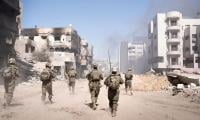Women who dare to assert their voice as human beings are anathema to a society in which misogyny has rested uncomfortably deep inside the social, economic and political food chains for thousands of years. But we are also a good people (I insist). So how do we manage our fundamental goodness with these deeply misogynistic postures towards women in general, and especially women that refuse to quietly accept what is given to them? Maybe we only love ‘em when they’re dead.
Asma Jahangir’s funeral was attended by plenty of people for whom the icon was larger in death than she was in life. I know, because I was among them. I always admired her incredible courage, and the fact that she would stand up alone when nobody would. It’s great to be in favour of young women choosing whether or not they want to marry someone in the age of Al Huda, and Instagram. Asma stood up to people with guns, at a time when those guns would be louder than all the newspaper columns and liberal instincts in the country put together.
Despite my admiration for her, I never told her how much she meant to my generation, how amazing it was that the women that I grew up with had mothers and sisters that were not alone. That Asma Jahangir was holding up the sky with them when no one else would. The enormity of her work was clearer to me as I processed her death than it ever was whilst she was alive.
The uncles in the generation before mine tell us similar stories about Fatima Jinnah. She was great as a silent sister to the Father of the Nation, but when she stood up to Field Marshal Ayub Khan, the same sister was fair game for every manner of our surplus of perfumed and shaven intellectual scud missiles. Hashtag, we’ve-seen-this-film-before. Madar-e-Millat is more revered as she rests in her grave than she was when she was alive and challenging Ayub.
But why go back to a black and white era? We are only a decade removed from the high definition assassination of Shaheed Mohtarma Benazir Bhutto. Death tried to wrestle her to the grave, and succeeded only after multiple tries. After losing her father, she had every reason to recede quietly into great wealth, and comfort. Instead she chose a life of defiance. It was only once she was dead that millions of men softened their posture toward BB. I know this also because, although I never hated her as viscerally as some privileged urban males, it took her assassination for me to realise just quite what she represented as a political force.
Perhaps neither Fatima Jinnah, nor Benazir Bhutto, nor Asma Jahangir however have been as widely reviled as the fifteen-year-old child from Swat who was shot in the head in 2012. Or perhaps it really is true: we only love ‘em when they’re dead. Alhamdolillah, Malala is very much alive. In her life men and boys in this country (and women and girls too) have a chance to embrace something larger than themselves, while it still lives and breathes.
Malala’s journey in our imaginations began when she was still a child, and it has survived not only the bullets of the Tehreek-e-Taliban, but also the war that the TTP and associated terrorist groups imposed on this country. A war that many men allowed to continue to be waged without challenge.
We are all old enough to remember when many of us tiptoed around the names and identities of terrorists. Many of us men. Men with privilege. Men with resources. Men with means. Men in uniform. Men in court. Men in newspapers. Men on television. A lecture or khutba for every occasion, on every issue – as long as the issue would not disturb the carefully set table of privilege that was always too fragile to disrupt too much. Throughout the ugly and dark days of this country’s cowardice toward the TTP and associated terror groups, that table setting was more important than whether children were getting an education or not. More important than what was happening to the voices of innocent victims of the TTP. More important than the sense of powerlessness that fathers felt throughout the Federally Administered Tribal Areas, throughout Swat, throughout any of the areas through which a bomb had exploded, or a terrorist had hidden. It was the conviction of a determined father, and the God-given grace and dignity of a little girl that shattered the silence. Malala channelled post-APS rage half a decade before APS happened. Half a decade before the rest of us. She was barely fifteen. And Alhamdolillah, Malala lives.
In Swat, as women were handing over their jewellery to the snake oil salesmen that were promising Muslimish Nirvana, Malala was asking questions about why little girls like her were being left to the mercy of the merchants of death the rest of us were too scared to challenge. In those heady days, there were three channels you could watch. You could watch the Pakistani state: a corrupt and broken concoction unable to provide running water, or decent schools, or a police that could serve and protect. You could watch Fazlullah: a Taliban emirate that offered public lashings, unmitigated bloodlust and darkness. Or you could watch the channel of resistance to this tyranny: personified by parents sending children to school, children going to school, teachers showing up and teaching – fearless.
Malala is that Pakistan. In 2014, it took an attack on Karachi airport, and the slaughter at APS, for us to catch up with Ziauddin and Malala, and everything that they represent. If there is a Nobel prize for doing the right thing half a decade after it should have been done, we all deserve what Malala has been given – but the bargain includes a bullet in the head and excommunication from our homes.
Of course, there is another way. We could stop obsessing over the messenger, and how we feel about her, and focus instead on the message.
Girls make up 48.48 percent of all high and higher secondary school enrolment in Punjab. Girls in the rest of the country don’t enjoy as much of a shot at going to high school, higher secondary, and by extension, college, or university or beyond. Girls as a percentage of the total students in high school and higher secondary school comprise only 38.74 percent in Sindh, 33.35 percent in Balochistan and only 25.51 percent in Khyber Pakhtunkhwa.
This is a life and death issue, because under-five child mortality falls from 112 per 1,000 births to mothers with no education down to 36 per 1,000 births for mothers with a high school education. Similar precipitous declines in mortality are observed at every level of education for every kind of child mortality.
A lack of girls’ education is murder, plain and simple. Like Malala did, you may be asking: where did this gender gap come from? Good question.
Of the 108,928 government primary schools in the country, only 36,180 are girls’ primary schools. This massive disparity has begun to be addressed at the middle, high and higher secondary levels, but largely on the back of a major push in Punjab. This country has cheated its women by building more schools for boys than for girls. The disparity is embedded in the system. And it is reflected all the way down to the district levels. Let’s take Swat district.
Swat has 802 boys’ primary schools to only 506 girls’ primary schools. The ratios get worse from there on. There are 82 boys’ middle schools for 42 girls’ middle schools, 79 boys’ high schools for 36 girls’ high schools, and 24 boys’ higher secondary schools for 11 girls’ higher secondary schools.
Taliban or no Taliban, should fathers and daughters in Swat continue to silently endure such disparities? No? Malala doesn’t think so either. Welcome to sanity. (We’re going to fix this, InshaAllah).
The writer is an analyst and commentator.
Representational image. — APP FileOnce again there is debate surrounding the National Finance Commission Award,...
Pakistani human rights activist and Supreme Court lawyer Asma Jahangir died on February 11, 2018. — AFPAn annual...
Representational image. — APP FileThe meltdown of Pakistan’s economy needs immediate attention. Political unrest...
A health worker administers polio vaccine drops to a child during a door-to-door polio vaccination campaign in Lahore,...
Armed militants of the banned Tehreek-e-Taliban Pakistan pose for a photograph in Orakzai Agency. —...
An aeroplane of the national flag carrier of Pakistan is seen in this file photo. — AFPWhile Pakistan considers...







